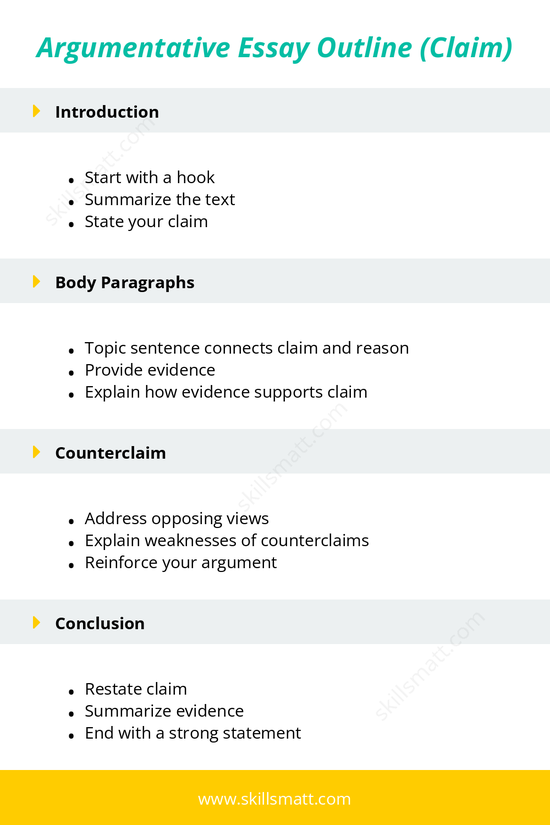Argumentative Essay Outline (Claim)
Writing an argumentative essay can initially feel overwhelming, but with a clear outline, you can break the process down into manageable steps. The core of an argumentative essay is presenting a claim and supporting it with strong evidence while addressing counterclaims. By following a structured outline, you can effectively make your case and persuade your reader of your position. Below is a detailed guide to help you structure an argumentative essay.
Introduction
The introduction of an argumentative essay is crucial because it sets the tone for your entire essay. The goal of the introduction is to grab the reader’s attention and clearly present your main argument or claim.
- Start with a hook: Begin with an attention-grabbing sentence that draws the reader in. You can use a relevant question, an interesting statistic, or a bold statement to spark interest.
- Summarize the issue: Briefly introduce the topic you will be discussing and give the reader some background information. This gives context to your claim and helps the reader understand why the issue is important.
- State your claim: Conclude your introduction by stating your main argument or position on the topic. This should be a clear and concise statement that outlines the stance you will defend throughout the essay.
Body Paragraphs
The body of your argumentative essay is where you will present the evidence and reasoning that support your claim. Each paragraph in this section should focus on one specific point related to your claim.
- Topic sentence: Start each body paragraph with a topic sentence that introduces the reason or argument you will discuss. This helps maintain clarity and keeps your essay well-organized.
- Provide evidence: Support your claim with solid evidence. Use facts, statistics, expert opinions, or real-life examples to demonstrate why your position is valid. The more credible your evidence, the stronger your argument will be.
- Explain the evidence: After presenting your evidence, explain how it supports your claim. Make the connection between the evidence and your argument clear, so the reader understands why it is relevant and persuasive.
Counterclaim
Addressing opposing viewpoints in your essay strengthens your argument and shows the reader that you have considered different perspectives. Acknowledging and refuting counterclaims can make your position even more compelling.
- Introduce the counterclaim: Present the opposing argument fairly and respectfully. It’s important to show that you understand the other side of the issue.
- Refute the counterclaim: Explain why the counterclaim is flawed or less convincing than your own argument. Provide evidence to back up your response and demonstrate the weaknesses in the opposing view.
- Reaffirm your claim: After addressing the counterclaim, return to your main argument and reinforce your position. This helps to remind the reader why your claim is stronger and more supported by evidence.
Conclusion
The conclusion is your final chance to leave a lasting impression on the reader. It should reinforce your argument and tie everything together in a coherent and impactful way.
- Restate your claim: Begin your conclusion by restating your claim, but don’t simply repeat it. Paraphrase your argument in a way that reflects the journey your essay has taken.
- Summarize your key points: Recap the most important pieces of evidence that support your claim. This reminds the reader of the strength of your argument.
- End with a strong statement: Conclude your essay with a powerful final thought. This could be a call to action, a thought-provoking question, or a statement that highlights the broader implications of the issue. A strong conclusion will leave a lasting impact on the reader.
By following this outline, you will be able to write a well-structured and persuasive argumentative essay. Remember, an effective argumentative essay requires not only presenting strong evidence but also addressing opposing views with respect and demonstrating why your claim holds more weight. Take your time to craft a thoughtful and compelling argument that will resonate with your reader.

